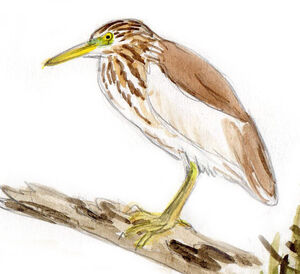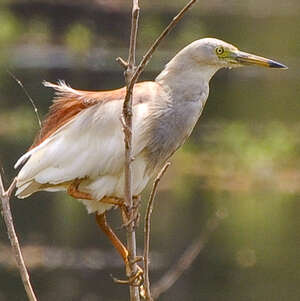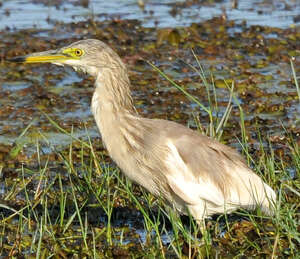Indian Pond Heron
Ardeola grayii - Crabier de Gray
Identification
The Indian Pond Heron, literally Indian pond heron, also called Paddybird by Anglo-Saxons: the bird of the rice fields, its Latin name Ardeola grayii coming from the English zoologist John Edward Gray (1800-1875).
Its appearance will completely change depending on its breeding period. In normal period, the head, neck and chest as well as a large part of the belly are striped with brown-gray vertical stripes on a white background. The lower belly is white to the tail, the mantle and back are almost the same color as the stripes, but a little darker, the primaries, supraalters are pale brown. The yellow legs turn salmon color during the mating season and the plumage will completely change: the back becomes dark brown, the nape, the cap, and partly the cheeks, become light gray, the neck passes from gray to yellowish. The transformation is total with the beak which has the lower jaw yellow and the upper jaw gray in normal period and which will become yellow on both parts with the black tip. Finally a white tuft appears on the nape during the nuptial period, a total transformation: two birds in one!
Subspecific information monotypic species
Foreign names
- Crabier de Gray,
- Garcilla india,
- papa-ratos-indiano,
- Paddyreiher,
- indiai üstökösgém,
- Indische Ralreiger,
- Sgarza indiana,
- rishäger,
- Mangrovehegre,
- čaplička ryžová,
- volavka hnědohřbetá,
- Rishejre,
- intianriisihaikara,
- martinet ros de l'Índia,
- Tjarnhegri,
- czapla siodłata,
- dīķu gārnis,
- indijska čopasta čaplja,
- Индийская прудовая цапля,
- インドアカガシラサギ,
- 印度池鹭,
- นกยางกรอกพันธุ์อินเดีย,
- 印度池鷺,
Habitat
Behaviour character trait
Often in small groups, they stay close to other herons or cormorants, standing on the edges of ponds and open water, sometimes alone. You can observe them on water lilies when hunting. Its often very hieratic position, and sudden flight have earned it the nickname in Sinhalese of Kana Koka or semi-blind heron, as if it only notices the person or animal disturbing it at the very last moment.
Flight
Dietfeeding habits
Completely eclectic: fish, amphibians, crustaceans, insects, leeches, dragonfly. Recent studies have shown that it varied its diet with various plants. Unfortunately, traces of metals have been observed on the tail feathers of some individuals from the south of India, probably from birds frequenting dumps.
Reproduction nesting
Indian Pond Heron nests in small colonies in mangroves and trees near lakes and ponds, but can also nest away from water, their nest is a platform of branches built at a height of about ten metres, the male brings branches and twigs to the female who builds the nest, the pair can use the same nest each year.
The breeding period starts in May and lasts until September, but can be delayed from November to February in South India and Sri Lanka. 3 to 5 eggs usually hatch over a period of 18 to 24 days. Both parents feed the chicks.Geographic range
Threats - protection
Sources of information
- IOC World Bird List (v15.1), Gill, F and D Donsker (Eds). 2025-12-07.
- A Field Guide to the Birds of the Indian Subcontinent, Krys Kazmierczak, Ber Van Perlo
- A Photographic GUIDE TO THE BIRDS OF INDIA, Bikran Grewal, Bill Harvey, Otto Pfister
- Vol. 1 - Handbook of the Birds of the World, Josep del Hoyo-Andrew Elliot-Jordi Sargatal
- Wikipédia, Wikipedia, The Free Encyclopedia
- BirdLife International, BirdLife International
- Avibase, Lepage Denis
- ARKive, Christopher Parsons
Other sources of interest
 Specification sheet created on
30/07/2023 by Anne et Gabriel Leboff
Specification sheet created on
30/07/2023 by Anne et Gabriel LeboffTranslation by AI Oiseaux.net
© 1996-2026 Oiseaux.net
- Accipitriformes
- Aegotheliformes
- Anseriformes
- Apodiformes
- Apterygiformes
- Bucerotiformes
- Caprimulgiformes
- Cariamiformes
- Casuariiformes
- Charadriiformes
- Ciconiiformes
- Coliiformes
- Columbiformes
- Coraciiformes
- Cuculiformes
- Eurypygiformes
- Falconiformes
- Galliformes
- Gaviiformes
- Gruiformes
- Leptosomiformes
- Mesitornithiformes
- Musophagiformes
- Nyctibiiformes
- Opisthocomiformes
- Otidiformes
- Passeriformes
- Pelecaniformes
- Phaethontiformes
- Phoenicopteriformes
- Piciformes
- Podargiformes
- Podicipediformes
- Procellariiformes
- Psittaciformes
- Pterocliformes
- Rheiformes
- Sphenisciformes
- Steatornithiformes
- Strigiformes
- Struthioniformes
- Suliformes
- Tinamiformes
- Trogoniformes






























